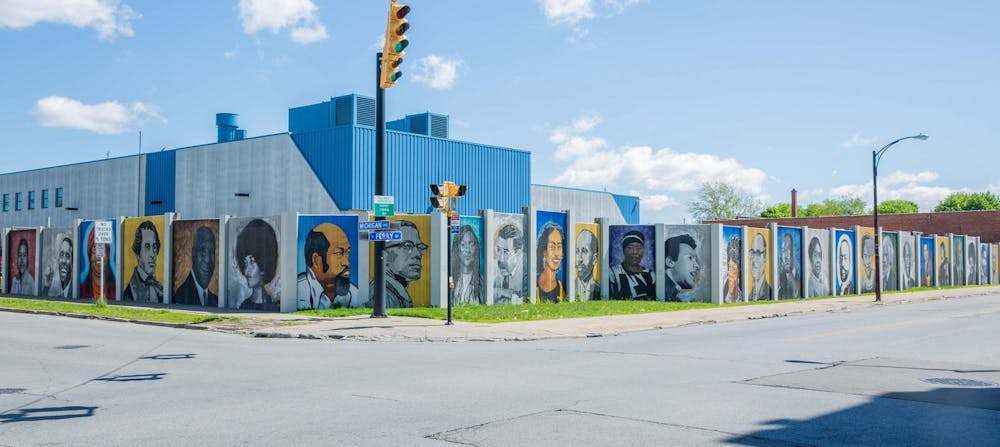Edreys Wajed is serious about his art. So serious that he put his life on hold — and everything on the line — to collaborate on his first professional mural, “Freedom Wall.”
“I was working full time taking care of a family, my wife and two kids,” Wajed, a second-year UB MFA student, said. “And in order for me to accept that opportunity, I had to pretty much take a leave of absence — no insurance, no salary, no check or anything — in order for me to be a part of that. And I think that the work that came out during that time and on that wall was some of my finest work.”
“Freedom Wall,” a collaboration between Wajed and three other Buffalo-based artists commissioned by the Albright-Knox’s Public Art Initiative, features portraits of 28 notable civil rights leaders from America’s past and present. Wajed said it is the only mural of his that he regularly visits, sometimes even driving out of his way just to see it.
“I’ve sat in front of and stared at it and tried to recall what I was thinking in 2017,” Wajed said. “It was a very challenging time for me.”
Wajed’s reason for making art comes down to two things: the desire to leave evidence of himself as an artist and the desire to inspire others.
“I just want to leave a legacy,” Wajed said. “When it’s all said and done, [I don’t want to have] never really given myself a chance through my skills. I think it’s unfortunate for people to live a life where, at the end of their years, they realize they hadn’t really bet on themselves or given themselves a shot with what they were skilled in.”
Wajed says he frequently incorporates his Black identity into his art because he feels it’s part of his duty to “highlight the invisible, or the silenced, or the oppressed.”
“Freedom Wall” is located at the intersection of Michigan Avenue and East Ferry Street in the Cold Springs neighborhood of Buffalo. Like many other neighborhoods where residents of color and impoverished people lived, Cold Springs was redlined in the late 1930s, according to the Partnership for the Public Good. Banks systematically denied mortgages — and home ownership — to the residents of redlined neighborhoods like Cold Springs, resulting in modern-day inequalities.
The mural is also located just a block away from a “grade B” and a “grade A” district, as they were redlined in 1937.
“It’s somewhat of my duty sometimes to portray Black imagery, sometimes in places where it’s not welcome, or sometimes in places where it’s not frequent, or even seen at all,” Wajed said. “It’s almost obligatory sometimes to beautify a space that has Black voice to it.”
Wajed’s murals adorn many of Buffalo’s buildings and often center around Black icons or Black experiences, such as his collaborative mural “Love Black” with James “Yames” Moffitt.
Wajed said he was inspired to create “Love Black, 2020,” located on the Say Yes Buffalo building on Main Street, following nationwide protests against police brutality in the wake of George Floyd’s murder. He wanted onlookers to “think about their biases and prejudices” and acknowledge “the lack of humanity” in how Black people are treated.
“I had been working on that concept for some time because I’m a father; I have two boys,” Wajed said. “And so the [message of] ‘love black boys even when they become men’ was something that I had been tinkering around with for awhile… I know first hand what it’s like to be a young Black kid because I was one myself, and now I’m a Black man, an adult, and I still face challenges.”
Wajed said his past experience as a visual arts teacher also informed his creative process.
Alongside his “Freedom Wall” and “Love Black, 2020” murals, Wajed is also the artist behind “Bailey Fights Blight” on Bailey Ave., a mural of John “Spider” Martin on Main Street and a portrait of John Lewis on Paderewski Drive. He has no intention of stopping and every intention of reaching his goals.
“I would love to see more of three things,” Wajed said. “I would love to see more love, humanity and compassion… That’s a big far-stretched dream, though. It’s almost — I don't want to say impossible, but it’s very lofty. However, that’s what I would sign off saying, if I had to write it to the world.”
The arts desk can be reached at arts@ubspectrum.com

Dominick Matarese is the Senior Features Editor at the Spectrum. He enjoys writing about interesting people, places, and things. In addition to running an independent blog, he has worked worked with the Owego Pennysaver, BROOME Magazine, the Fulcrum Newspaper, and Festisia. He is passionate about music journalism and can be found enjoying live music most weekends.





